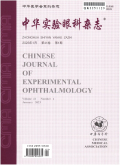基于深度学习OCT辅助诊断湿性年龄相关性黄斑变性算法的应用
The application value of deep learning OCT on wet age-related macular degeneration assisted diagnosis
摘要目的 探讨基于深度学习光相干断层扫描(OCT)辅助诊断湿性年龄相关性黄斑变性(wAMD)算法的应用价值.方法 在仅能提供有无疾病作为标记的前提下,首先基于ResNet-101深度模型训练一个深度神经网络来自动判断患者是否患有wAMD疾病,其次将基于弱监督深度学习的算法应用于OCT图像自动辅助诊断wAMD的疾病区域,同时使用热力图为医生诊断疾病区域提供依据.基于弱监督的深度学习,使用了一种新型的网络算法结构应用于眼科OCT图像的疾病区域检测中,同时通过改进传统病灶区域生成方式来提高病灶热力图的准确性,通过重新组合神经网络中的权重神经元的数值生成病灶热力图,最后通过计算算法预测正确的结果 占所有预测结果的比重得到最终的算法准确率.结果基于Resnet的深度学习算法对于wAMD的诊断准确率达到94.9%,远高于AlexNet的85.3%、VGG的88.7%和Google-Net的89.2%;同时热力图通过不同的颜色为医生提供更方便的辅助诊断依据.结论 相比较原始的基于疾病区域标记作为经验知识的分类网络,基于弱监督学习的深度学习算法模型在无需提供疾病区域标记的前提下,不仅在眼底疾病分类上有较好的结果,还能标记潜在的病灶区域,为wAMD的诊断提供病灶区域的判断依据.
更多相关知识
abstractsObjective To investigate the application value of deep learning optical coherence tomography ( OCT) on wet age-related macular degeneration ( wAMD) assisted diagnosis. Methods Weakly supervised deep learning algorithms was applied on the premise that only disease or not can be provided as a marker. The OCT image automatically assisted in the diagnosis of diseased areas of wAMD,and thermograms were applied to provide a basis for doctors to detect disease areas. Based on the deep learning of weak supervision,a new network algorithm structure was proposed for detecting disease area in ophthalmic OCT images. At the same time, thermograms were adopted to improve the accuracy of the lesion map,which is the location of the lesion area. This study followed the Declaration of Helsinki. This study protocol was approved by Ethic Committee of Ningbo Eye Hospital ( No. 2018-YJ05 ) . Written informed consent was obtained from each subject before entering study cohort. Results Resnet-based deep learning algorithm gave a diagnostic accuracy rate of 94. 9% for the disease, which was much higher than that of AlexNet 85. 3%,VGG 88. 7%, and Google-Net 89. 2%. The thermograms with different colors provided a more convenient auxiliary diagnosis basis for doctors. Conclusions Compared with the original classification network,which needs disease area markers as empirical knowledge, deep learning algorithm model not only provides better results in the classification of retinal diseases,but also marks potential disease areas. The lesion area provides a basis for judging the area of the lesion for the diagnosis of wAMD.
More相关知识
- 浏览149
- 被引13
- 下载149


相似文献
- 中文期刊
- 外文期刊
- 学位论文
- 会议论文



 换一批
换一批 换一批
换一批



